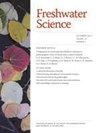栖息的涵洞和自然障碍物限制了鱼类在间歇性草原溪流中的扩散
IF 1.6
4区 环境科学与生态学
Q3 ECOLOGY
引用次数: 1
摘要
修建不良的十字路口阻碍了鱼类向上游流动,而这些河流提供了重要的栖息地,或将孤立的种群联系在一起。尽管清除这些屏障通常是保护的首要任务,但对清除后鱼类通道的量化研究还没有得到很好的研究,特别是在间歇性溪流中。在这项研究中,我们试图了解障碍如何影响间歇性草原溪流中鱼类的扩散。我们使用无源集成收发器标签和天线站,对3种草原溪流鱼类(Central Stoneroller Campostoma anomalum [Rafinesque, 1820]、Southern Redbelly Dace Chrosomus erythrogaster [Rafinesque, 1820]和Creek Chub Semotilis atromaculatus [Mitchill, 1818])在移除悬空的涵洞之前和之后的3个小时内通过间歇草原溪流的十字路口进行了鱼类运动。我们证实,尽管在涵洞下方的间歇河段有大量被标记的鱼聚集,但没有上游鱼类通过涵洞移动。相比之下,在移除后的3个y中,所有3种的标记个体都在十字路口上方检测到。我们还追踪了这些物种的恢复情况,加上Orangethroat Darter Etheostoma spectabile (Agassiz, 1854),在2018年的严重干旱之后,在两条春季供水的支流中,一条没有下游屏障,另一条下游涵洞被拆除。对支流的调查表明,在没有下游屏障的支流干旱后,鱼类密度迅速恢复。然而,被拆除涵洞上方的修复工作似乎受到天然瀑布的限制。我们的观察结果表明,屏障的移除使它们能够进入产卵栖息地,但其他障碍或通往多年生泉水支流的剪切距离也限制了在严重干旱后的再定居。草原河流多年生河段和间歇河段之间的连通性增加,可能对鱼类有益,因为它增强了它们对干扰的适应能力,并在关键的生命阶段提供了栖息地。本文章由计算机程序翻译,如有差异,请以英文原文为准。
A perched culvert and natural obstructions limit fish dispersal in an intermittent prairie stream
Poorly constructed road crossings block upstream movement of fish into stream reaches that provide critical habitat or connect isolated populations. Although removing these barriers is often a conservation priority, quantifying fish passage following removal has not been well studied, particularly in intermittent streams. In this study, we sought to understand how barriers influence the dispersal of fishes in intermittent prairie streams. We used passive integrated transponder tags and antenna stations to quantify fish movement of 3 prairie-stream fishes (Central Stoneroller Campostoma anomalum [Rafinesque, 1820], Southern Redbelly Dace Chrosomus erythrogaster [Rafinesque, 1820], and Creek Chub Semotilis atromaculatus [Mitchill, 1818]) through a road crossing in an intermittent prairie stream for 3 y before and 3 y after removing a perched culvert. We verified that no upstream fish movement occurred through the culvert, despite large aggregations of tagged fish in the intermittent reach below the culvert. In contrast, tagged individuals of all 3 species were detected above the road crossing in each of the 3 y following removal. We also tracked the recovery of these species, plus the Orangethroat Darter Etheostoma spectabile (Agassiz, 1854), following a severe drought in 2018 in 2 spring-fed tributary reaches, 1 without a downstream barrier and 1 with the removed downstream culvert. Surveys of the tributary reaches showed rapid recovery of fish densities following drought in the tributary without a downstream barrier. However, recovery at the site above the removed culvert appeared to be limited by a natural waterfall. Our observations suggest barrier removal allowed access to spawning habitat within the intermittent reach immediately upstream of the site, but other obstacles or shear distance to perennial spring-fed tributary reaches also limited recolonization following severe drought. Increased connectivity between perennial and intermittent reaches in prairie streams likely benefits fishes by increasing their resilience following disturbance and providing habitat during critical life stages.
求助全文
通过发布文献求助,成功后即可免费获取论文全文。
去求助
来源期刊

Freshwater Science
ECOLOGY-MARINE & FRESHWATER BIOLOGY
CiteScore
4.10
自引率
0.00%
发文量
49
审稿时长
6-12 weeks
期刊介绍:
Freshwater Science (FWS) publishes articles that advance understanding and environmental stewardship of all types of inland aquatic ecosystems (lakes, rivers, streams, reservoirs, subterranean, and estuaries) and ecosystems at the interface between aquatic and terrestrial habitats (wetlands, riparian areas, and floodplains). The journal regularly features papers on a wide range of topics, including physical, chemical, and biological properties of lentic and lotic habitats; ecosystem processes; structure and dynamics of populations, communities, and ecosystems; ecology, systematics, and genetics of freshwater organisms, from bacteria to vertebrates; linkages between freshwater and other ecosystems and between freshwater ecology and other aquatic sciences; bioassessment, conservation, and restoration; environmental management; and new or novel methods for basic or applied research.
 求助内容:
求助内容: 应助结果提醒方式:
应助结果提醒方式:


